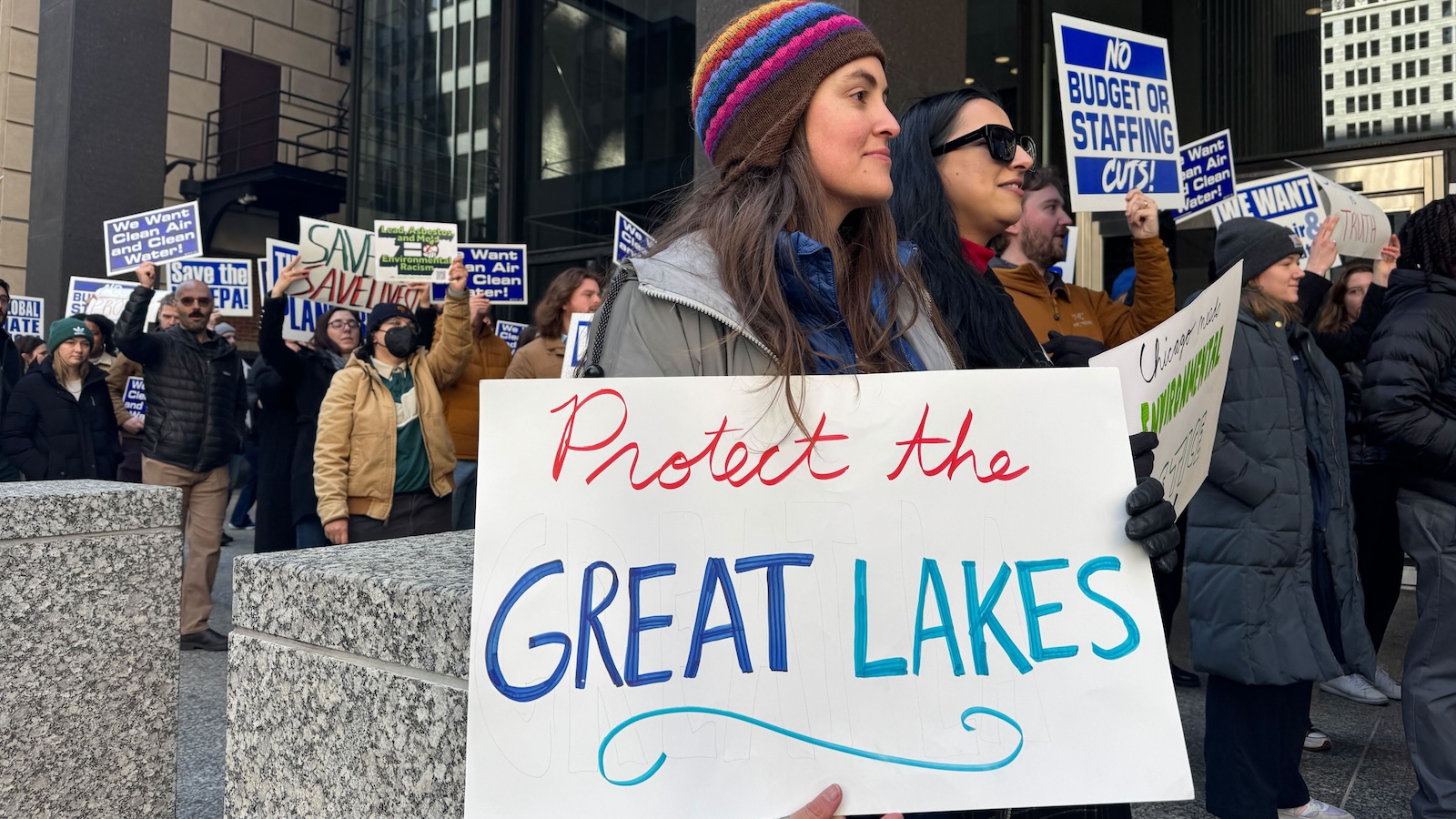This coverage is made possible through a partnership between Grist, Interlochen Public Radio in Northern Michigan, and WBEZ, a public radio station serving the Chicago metropolitan region.
Great Lakes Day is an annual summit where politicians and officials of all stripes gather in Washington, D.C., to demonstrate their commitment to the region home to the largest freshwater ecosystem on the planet. For years, leaders from the United States and Canada have met at the event without incident. But earlier this month and amid a tariff dispute between the two nations, the Trump administration abruptly disinvited two Canadian mayors from the long-standing White House meeting.
The last-minute exclusion of Montreal Mayor Valérie Plante and St. Catharines Mayor Mat Siscoe came just 48 hours before the event due to “diplomatic protocols,” according to Christine Maydossian, a spokesperson for the Great Lakes and St. Lawrence Cities Initiative, which coordinates the meeting and submitted the names of the two Canadian mayors and one American to White House officials a month earlier.
Neither Canadian mayor responded to a request for comment.
Since taking office in January, President Donald Trump and his administration has repeatedly stoked tensions with Canada, once considered the United States’ closest ally. Along with trade and tariffs, this strife has also raised questions about how the region’s water resources will be managed. Amid the escalating political tensions, some Great Lakes advocates worry the diplomatic snub is a warning sign that one of the world’s most successful examples of water-sharing could become collateral damage in a geopolitical rift.
“We are worried that maybe behind all this is the idea that a country one day will be able to take water out of the Great Lakes and manage water not as an ecosystem that needs to be preserved in its watershed, but as a resource, as a commodity,” said Jérôme Marty, speaking as the director of the International Association for Great Lakes Research.
The New York Times reported earlier this month that in calls with then-Prime Minister Justin Trudeau, Trump had “mentioned revisiting the sharing of lakes and rivers between the two nations.”
“President Trump has made clear the need for Canada to stop ripping off the United States on trade. President Trump will explore any and all actions that put the interests of America first,” said Brian Hughes, a spokesperson with the National Security Council, in an emailed statement to Grist. (The White House did not respond directly to Grist’s questions about cooperation between the two countries concerning the Great Lakes.)
For over a century, the United States and Canada have worked in tandem to manage four of the five Great Lakes that straddle both countries: Superior, Huron, Erie, and Ontario. That cooperative arrangement — with which the countries settle everything from water use to navigation to invasive species to pollution — may now be on the line.
“We cannot let this be sacrificed,” said Rachel Havrelock, a professor at the University of Illinois Chicago who directs the Freshwater Lab, an environmental research initiative focused on the Great Lakes and environmental justice.
“This is the most stable, productive, and mutually beneficial form of binational water governance on Earth,” she added.
The lakes provide drinking water for more than 30 million people spread across both sides of the border. The U.S. and Canada, then under British rule, signed the Boundary Waters Treaty in 1909, a highly-praised water sharing agreement that formed the International Joint Commission, or IJC, a binational organization that aims to prevent and resolve disputes over shared lakes and rivers.
(The arrangements between the two countries long sidelined Indigenous nations, some of which the U.S.-Canada border artificially bisected. For example, the IJC did not invite Indigenous representatives to participate until the 1980s, despite the sovereign rights of those nations. Indigenous communities often face disproportionate impacts from pollution and climate change, and recent IJC assessments have acknowledged that strengthening relationships with Indigenous governments is key to improving its response to those threats.)
The relationship was further cemented by the Great Lakes Fishery Commission, established in 1955, which coordinates how invasive species and fisheries are managed, and again by the 1972 Great Lakes Water Quality Agreement, which committed the two nations to “restore and maintain” the health of the lakes.
Those are just three among a layered patchwork of treaties and other agreements between local, state, federal, and tribal governments that determine Great Lakes management. Some don’t necessarily rely on federal involvement, such as the Great Lakes Agreement and Compact, which protects the water from being shipped to other states and regions.
Trump has cast doubt on the stability of these agreements by breaking a series of diplomatic taboos, including calling Canada the “51st state” and halting negotiations on the Columbia River Treaty, after referring to the British Columbia river as a “large faucet” that could be used to solve California’s water crisis last year.
Policy experts say Trump’s recent tack raises a red flag for the future of the Great Lakes.
“The water and the resources don’t recognize international boundaries,” said Mike Shriberg, a faculty member at the University of Michigan who specializes in Great Lakes policy. “You can’t manage things like invasive species from only one country and not the other. You can’t manage harmful algal blooms from one country or the other. The information on the flow of ice and what that means for shipping has to be shared across borders.”
Shriberg said the Trump administration’s funding freeze and staffing cuts related to management of the lakes are impacting how the U.S. will protect them and meet its obligations with Canada — concerns that prompted him to write an op-ed making the case for politicians to unify to protect the Great Lakes.
Some areas have shown signs of revival; the Great Lakes Fishery Commission’s sea lamprey program can begin rehiring U.S. federal workers to control the invasive species, which can wreak havoc on other fish. That means the program will move forward, albeit weeks behind schedule.
But other threats are visible, according to Shriberg: There are more bureaucratic roadblocks to federal scientists working with their Canadian counterparts on everything from harmful algal blooms to flooding — work he said had until this point been “seamless.”
“It’s often not happening because of the chaos within the agencies that’s being caused by all the cutbacks,” Shriberg said.
Those cutbacks have reached the NOAA Great Lakes Environmental Research Laboratory, which has been rocked by staffing upheavals, with a fifth of their employees reportedly retiring, resigning, fired, or on leave, including the communications team.
“You’re already seeing a breakdown in capacity to do the basic work that we need to protect the lakes,” he said.



